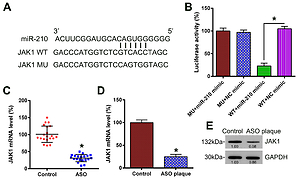Current issue
Archive
Manuscripts accepted
About the Journal
Editorial office
Editorial board
Section Editors
Abstracting and indexing
Subscription
Contact
Ethical standards and procedures
Most read articles
Instructions for authors
Article Processing Charge (APC)
Regulations of paying article processing charge (APC)
VASCULAR SURGERY / RESEARCH PAPER
miR-210 regulates vascular endothelial cell apoptosis in arteriosclerosis obliterans through the JAK1-STAT3 pathway
1
Ningbo Huamei Hospital, Chinese Academy of Sciences, China
Submission date: 2020-01-03
Final revision date: 2020-07-06
Acceptance date: 2020-07-26
Online publication date: 2021-04-18
RELATED ARTICLE
KEYWORDS
TOPICS
ABSTRACT
Introduction:
Atherosclerosis is a continuously worsening chronic condition that starts in the arteries and may then affect other blood vessels. There is increasing evidence linking microRNAs to the development of arteriosclerosis obliterans (ASO). Quantitative reverse transcription polymerase chain reaction (qRT-PCR) was applied in this study to detect miR-210-5p (miR-210) expression, and significant upregulation was observed in human arterial walls where ASO was prevalent.
Material and methods:
The proliferation of human umbilical vascular endothelial cells (HUVECs) with various levels of miR-210 expression was assessed via MTT and colony-formation assays. Cell proliferation was significantly promoted in HUVECs with upregulated miR-210 levels and reduced in HUVECs with downregulated miR-210 levels.
Results:
Flow cytometric analysis of cells stained with annexin V-FITC and propidium iodide data demonstrated that miR-210 inhibited apoptosis, while miR-210 inhibition promoted apoptosis by mediating pro-apoptotic protein expression levels. These results were verified using a dual-luciferase reporter gene assay system, which showed that Janus kinase 1 (JAK1) was directly targeted by miR-210, while an miR-210 mimic significantly decreased downstream JAK1 and signal transducer and activator of transcription 3 (STAT3) activation at a post-transcriptional level in HUVECs, as detected by western blotting and qRT-PCR. Further inhibition of either JAK1 or STAT3 counteracted the effect of miR-210 on HUVEC proliferation and apoptosis. These findings suggest that miR-210 promotes HUVEC proliferation, at least in part, by targeting the JAK1-STAT3 signaling axis.
Conclusions:
This study provides insights into the contribution of the miR-210-JAK1-STAT3 axis and its underlying mechanisms to ASO pathology.
Atherosclerosis is a continuously worsening chronic condition that starts in the arteries and may then affect other blood vessels. There is increasing evidence linking microRNAs to the development of arteriosclerosis obliterans (ASO). Quantitative reverse transcription polymerase chain reaction (qRT-PCR) was applied in this study to detect miR-210-5p (miR-210) expression, and significant upregulation was observed in human arterial walls where ASO was prevalent.
Material and methods:
The proliferation of human umbilical vascular endothelial cells (HUVECs) with various levels of miR-210 expression was assessed via MTT and colony-formation assays. Cell proliferation was significantly promoted in HUVECs with upregulated miR-210 levels and reduced in HUVECs with downregulated miR-210 levels.
Results:
Flow cytometric analysis of cells stained with annexin V-FITC and propidium iodide data demonstrated that miR-210 inhibited apoptosis, while miR-210 inhibition promoted apoptosis by mediating pro-apoptotic protein expression levels. These results were verified using a dual-luciferase reporter gene assay system, which showed that Janus kinase 1 (JAK1) was directly targeted by miR-210, while an miR-210 mimic significantly decreased downstream JAK1 and signal transducer and activator of transcription 3 (STAT3) activation at a post-transcriptional level in HUVECs, as detected by western blotting and qRT-PCR. Further inhibition of either JAK1 or STAT3 counteracted the effect of miR-210 on HUVEC proliferation and apoptosis. These findings suggest that miR-210 promotes HUVEC proliferation, at least in part, by targeting the JAK1-STAT3 signaling axis.
Conclusions:
This study provides insights into the contribution of the miR-210-JAK1-STAT3 axis and its underlying mechanisms to ASO pathology.
Share
RELATED ARTICLE
We process personal data collected when visiting the website. The function of obtaining information about users and their behavior is carried out by voluntarily entered information in forms and saving cookies in end devices. Data, including cookies, are used to provide services, improve the user experience and to analyze the traffic in accordance with the Privacy policy. Data are also collected and processed by Google Analytics tool (more).
You can change cookies settings in your browser. Restricted use of cookies in the browser configuration may affect some functionalities of the website.
You can change cookies settings in your browser. Restricted use of cookies in the browser configuration may affect some functionalities of the website.



